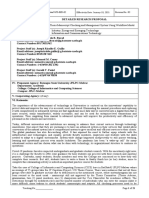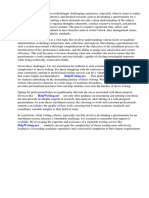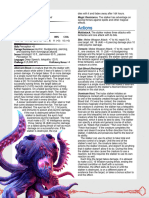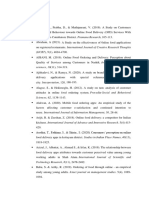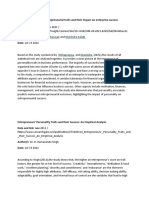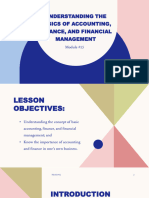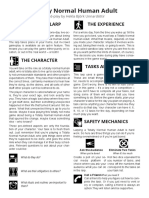Scipro Cems Meeting 1 February
Scipro Cems Meeting 1 February
Uploaded by
api-159873591Copyright:
Available Formats
Scipro Cems Meeting 1 February
Scipro Cems Meeting 1 February
Uploaded by
api-159873591Original Title
Copyright
Available Formats
Share this document
Did you find this document useful?
Is this content inappropriate?
Copyright:
Available Formats
Scipro Cems Meeting 1 February
Scipro Cems Meeting 1 February
Uploaded by
api-159873591Copyright:
Available Formats
Ken Larsson from the Department of Computer and Systems Sciences at Stockholm University presented a paper entitled, The
challenge for supervision: Mass individualisation of the thesis writing process with
less resources, at Online Educa Berlin 2011. In this presentation, he briefly introduced a system that they
developed, Sci Pro (Scientific process and outcomes).
I believe their system could add value to the postgraduate supervision process in CEMS, based on the following.
The developers of SciPro believe that universities need to renew and transform their way of organising education in order to be more suitable for today's youth and their digital lifestyle. The vision, Education for
all, further requires radically new teaching methods in order to enable fair opportunities for larger numbers of students. In light of the large number students admitted, many may not be suitably qualified, and require more teaching and supervision time. University staff consequently faces increasing teaching loads and more students to supervise. They further believe that some of the challenges for higher education such as a high non-
completion rate of postgraduate studies can be addressed by a conceptual framework that they developed, which is implemented by means of an Information technology (IT)-support system for theses at universities worldwide.
The developers point of departure is that the core of university activities is to educate students to understand and apply scientific methods and theories. This manifests itself primarily in independent projects at various degree levels ranging from bachelor to doctoral level. In light of this, they focused on the creation of a scalable and modular IT system that motivates and supports students and supervisors in the scientific process that leads to a finished thesis.
Open Rubric
Integration between each universitys other existing IT systems. Users should experience it as one system, not as a lot of fragmented and isolated "islands". This means both inter-operability between administrative systems such as, for instance student registration and grade reporting, as well as individualised transition between different courses, coherent administration, degrees and working. Furthermore, one should be able to move smoothly through integrated solutions between the IT systems that young people use today in their daily lives such as Twitter, Facebook and YouTube and the universitys IT infrastructure. Learning occurs in both formal and informal settings and thresholds should be as low as possible.
No IT initiatives will be accepted by researchers, teachers or administrators or decision makers in an academic organisation, if they take more time. When IT support however, can enhance and refine existing processes and save time, they may be interested. Meta-supervision support means that a comprehensive guidance is provided by IT resources, so that the supervisor does not need to say the same thing over and over again to new or more students regarding basic requirements for the degree project, methodological approach, content and structure. This information is conveyed through dynamic checklists for different phases of the research process, quality selection of e-resources, interactive videos and more.
How research can be conducted and what the process might look like may be exemplified in a much more engaging way for students. To accomplish this, the developers use narrative techniques from cinema as well as innovative technologies, which mainly take the form of hyper video presentations. Different video layers are related to other resources such as videos, texts, and web pages in a mind map-like fashion. These video overviews reduce supervisors need to repeat core content and provide self-study opportunities for students. Embedded in the videos are activating tasks and assignments linked to reward systems inspired by computer games such as meta-rewards.
The process is reinforced by, among other things: a) "State of Mind - indicator", the student indicates if he/she needs support in real time, b) a online peer review system that organises large numbers of students, so that they can receive and give feedback on each other's manuscripts in various stages based on prepared checklists. This changes the problem of supervising many students from a time-consuming disadvantage into a timesaving and quality improvement resource. The peer-review system is completely student driven, thus it will not take supervisors time to arrange peer-reviews. However, supervisors can access reviews and assess their quality if they want.
Completed mandatory milestones are visualised with automatic progress indicators showing how much has been done and are left to do in order to complete the thesis. Many students have difficulties structuring their time when left without a schedule, therefore the feature Activity plan is part of the system in order to help structure timeplanning. Both the supervisor and the student can see the activities planned, and reminders are sent before milestones and if the student is after his/her plan. Many theses are not completed within the allotted time frame and many are not completed at all because of unclear requirements and schedules.
The system makes possible supervisor teams with external supervisors from the business and public sectors. External agents can provide ideas for theses that are relevant to industry through the Idea bank. Theses may be completed at the company or abroad and supervised by distance technology through the integrated system with several different types of supervisors who have different responsibilities and roles.
In addition to research methodology and subject knowledge, a thesis needs to contain a new dimension: a new question and/or new interpretation of data, and/or a new service, process or product. The system structures relevant methodological content, but also provides support for creativity. Some students need creativity support more than others, while others have greater need for help to structure their creativity with the methodological skills. The system intends to support both student profiles. An integrated anti-plagiarism system makes it easier for teachers to control textual originality and even plagiarized images, tables and program code. To control and curb cheating in higher education has become more time consuming and extensive in recent years. Advanced integrated support for this that goes beyond text matching system really enhances quality assurance. 4
Figure 1 illustrates the benefits of the SciPro system for different stakeholders. The primary target group are the two individuals; supervisor and student. The supervisor benefits by saving approximately 50% of time previously devoted to administration and basic requirements, instructions and low level feedback. The student gains approximately 100 extra supervisor hours by the features built in the system, which enables self-regulated and focused learning and activities necessary to accomplish the thesis. From an organisational point of view the main benefactors are higher education institutions and business sectors. The system enables larger student numbers within existing resources.
It appears as if we would be able to adopt some of the contents of this system for our own purposes, for instance, by investigating how it can address the list of targets identified in Table 1 in our environment. The developers have only recently begun collaborating with other universities (the University of Finland). We could add value by being the first South African (African) to adopt the system and investigating its relevance in an ODL environment and synergies in this type of context. 8
You might also like
- Oral Defense ScriptDocument31 pagesOral Defense ScriptFernan Enad82% (17)
- Computerized Student Information SystemDocument72 pagesComputerized Student Information SystemJoey Cereno63% (19)
- TUP-T Guidance and Information System Documentation Chapter 1 To 5Document91 pagesTUP-T Guidance and Information System Documentation Chapter 1 To 5Chammy Pantaleon89% (76)
- Necromunda TerrainDocument42 pagesNecromunda Terraineardstapa100% (4)
- Macbeth Essay RubricDocument1 pageMacbeth Essay Rubricapi-455169907100% (1)
- Sample Introduction Thesis Enrollment SystemDocument8 pagesSample Introduction Thesis Enrollment Systemdwsdzrcq100% (2)
- Online Enrollment System Thesis SampleDocument5 pagesOnline Enrollment System Thesis Sampleticwsohoress1974100% (2)
- Thesis School Management SystemDocument8 pagesThesis School Management Systemgjhr3grk100% (1)
- Enrollment SystemDocument9 pagesEnrollment SystemNeil Joseph Alcala100% (1)
- Online Grading System Thesis SampleDocument6 pagesOnline Grading System Thesis Samplefjcz1j5g100% (2)
- New E-Learning Method Using DatabasesDocument12 pagesNew E-Learning Method Using Databasesdedeman1100% (2)
- BatStateU FO RES 02 - Detailed Research Proposal Rev. 02 - ThesisCheckingDocument21 pagesBatStateU FO RES 02 - Detailed Research Proposal Rev. 02 - ThesisCheckingLesterSanchezCuevaNo ratings yet
- Online Enrollment System Thesis TagalogDocument7 pagesOnline Enrollment System Thesis Tagalogcamellataylorhighpoint100% (2)
- Learning Management Systems in Higher Education: July 2014Document7 pagesLearning Management Systems in Higher Education: July 2014Kishore SmartNo ratings yet
- Chapter OneDocument10 pagesChapter OneGemechis ShiferawNo ratings yet
- Chapter IDocument8 pagesChapter IErmercadoNo ratings yet
- Student Tuition FessDocument7 pagesStudent Tuition FessAjewole Eben TopeNo ratings yet
- Week 4 Change ProcessDocument5 pagesWeek 4 Change Processapi-223837372No ratings yet
- Questionnaire For Thesis Enrollment SystemDocument8 pagesQuestionnaire For Thesis Enrollment Systemmichellebrownbillings100% (2)
- Final Report BcaDocument48 pagesFinal Report Bcapruthvimgowda1997No ratings yet
- Enrollment System Thesis Related LiteratureDocument4 pagesEnrollment System Thesis Related Literaturesusanmigliacciostamford100% (1)
- Scheduling Systems Are Used by Organizations To Allocate and Manage TheirDocument14 pagesScheduling Systems Are Used by Organizations To Allocate and Manage TheirPaolo TenorioNo ratings yet
- School Record Management System ThesisDocument8 pagesSchool Record Management System Thesisdngw6ed6100% (2)
- Grading System Thesis SampleDocument5 pagesGrading System Thesis Samplegj3vfex5100% (1)
- Enrollment System Thesis Documentation DownloadDocument5 pagesEnrollment System Thesis Documentation Downloaddnr3krf8100% (1)
- Thesis Documentation Enrollment SystemDocument4 pagesThesis Documentation Enrollment Systemafcnzfamt100% (2)
- Attendance Monitoring System Related Literature ThesisDocument6 pagesAttendance Monitoring System Related Literature ThesisProfessionalCollegePaperWritersMcAllen100% (2)
- ETEC588 Innovation DecisionDocument6 pagesETEC588 Innovation DecisionKerry WhiteheadNo ratings yet
- Thesis Attendance Monitoring SystemDocument6 pagesThesis Attendance Monitoring Systembsr3rf42100% (1)
- Literature Review On Student Result Management SystemDocument4 pagesLiterature Review On Student Result Management SystemafmziepjegcfeeNo ratings yet
- Thesis Enrollment SystemDocument6 pagesThesis Enrollment Systemidmcgzbaf100% (1)
- Online Enrollment System Thesis IntroductionDocument7 pagesOnline Enrollment System Thesis IntroductionNeedHelpWriteMyPaperUK100% (2)
- Chapter 1 - Enrollment System For SADDocument26 pagesChapter 1 - Enrollment System For SADDylone AlfonNo ratings yet
- Online E-Learning Portal System Synopsis - RemovedDocument6 pagesOnline E-Learning Portal System Synopsis - RemovedSanjay H MNo ratings yet
- Online Enrollment System ThesisDocument8 pagesOnline Enrollment System Thesisdenisehudsonfortwayne100% (2)
- Sample Thesis Online Enrollment SystemDocument5 pagesSample Thesis Online Enrollment SystemPayForSomeoneToWriteYourPaperEverett100% (2)
- 10441-Article Text-18593-1-10-20210812Document6 pages10441-Article Text-18593-1-10-20210812Sunil SharmaNo ratings yet
- Online Enrollment System Thesis Related LiteratureDocument6 pagesOnline Enrollment System Thesis Related LiteratureBuyingPapersOnlineCollegeCanada100% (2)
- 3Document58 pages3Vasanth NNo ratings yet
- Enrollment System Thesis Documentation PDFDocument5 pagesEnrollment System Thesis Documentation PDFsheilaphillipspueblo100% (1)
- Review of Related LiteratureDocument5 pagesReview of Related LiteraturenyakNo ratings yet
- Dr. Supten Sarbadhikari,: Founding ChairDocument30 pagesDr. Supten Sarbadhikari,: Founding ChairPankaj MaheriaNo ratings yet
- Course Reg 1-7Document36 pagesCourse Reg 1-7Adym Aymd100% (1)
- Sample Thesis Documentation Enrollment SystemDocument6 pagesSample Thesis Documentation Enrollment Systemangieloveseattle100% (1)
- Project Proposal On SMSDocument12 pagesProject Proposal On SMSbk channelNo ratings yet
- Thesis Proposal Enrollment SystemDocument6 pagesThesis Proposal Enrollment SystemCollegePaperWriterLittleRock100% (2)
- Thesis Voting SystemDocument7 pagesThesis Voting SystemSomeoneWriteMyPaperSavannah100% (2)
- Chapter N0 1Document7 pagesChapter N0 1Ali RazaNo ratings yet
- FLP Chapter 1 3 8 18 23Document46 pagesFLP Chapter 1 3 8 18 23Jose Marie De VeraNo ratings yet
- Literature Review of Design and Implementation of An Online Student Admission SystemDocument4 pagesLiterature Review of Design and Implementation of An Online Student Admission SystemafmzsbnbobbgkeNo ratings yet
- Sample Thesis Introduction in Enrollment SystemDocument7 pagesSample Thesis Introduction in Enrollment Systembrookelordmanchester100% (2)
- Web Based ELearning in Computer Hardware Capstone DocumentationDocument2 pagesWeb Based ELearning in Computer Hardware Capstone Documentationcx4phakz ruizNo ratings yet
- Online Enrollment System Thesis PDFDocument5 pagesOnline Enrollment System Thesis PDFuywodgikd100% (2)
- Framework For EvaluationDocument43 pagesFramework For EvaluationkevinbraceNo ratings yet
- Record Management System Thesis IntroductionDocument4 pagesRecord Management System Thesis IntroductionRick Vogel100% (2)
- An Instructional Design Approach To Updating An Online Course CurriculumDocument21 pagesAn Instructional Design Approach To Updating An Online Course CurriculumRt SaragihNo ratings yet
- Records Management DissertationsDocument7 pagesRecords Management DissertationsWriteMyStatisticsPaperSingapore100% (1)
- Collaboration PlatfoemDocument4 pagesCollaboration PlatfoemDusty FootNo ratings yet
- Fernando A. Pajar JR.: AccommodationDocument2 pagesFernando A. Pajar JR.: AccommodationFernandoNo ratings yet
- Final-Findings Report 2Document5 pagesFinal-Findings Report 2api-323661991No ratings yet
- Why Use School Information Software?: Keys to Making Sense of K-12 SoftwareFrom EverandWhy Use School Information Software?: Keys to Making Sense of K-12 SoftwareNo ratings yet
- Learning Analytics Cookbook: How to Support Learning Processes Through Data Analytics and VisualizationFrom EverandLearning Analytics Cookbook: How to Support Learning Processes Through Data Analytics and VisualizationNo ratings yet
- Generic RubricDocument3 pagesGeneric Rubricapi-159873591No ratings yet
- Mde601 Skillbuilders Rubric v3Document2 pagesMde601 Skillbuilders Rubric v3api-159873591No ratings yet
- Omde601 Assignment Rubric v21Document1 pageOmde601 Assignment Rubric v21api-159873591No ratings yet
- Leona Ungerer OMDE 601 Section 9040: Open RubricDocument7 pagesLeona Ungerer OMDE 601 Section 9040: Open Rubricapi-159873591No ratings yet
- Online Learning 1Document12 pagesOnline Learning 1Md Azani ShamNo ratings yet
- Reciprocante Compresor IrDocument20 pagesReciprocante Compresor IrJose MontielNo ratings yet
- Eci 80Document3 pagesEci 80kishore varmaNo ratings yet
- Sordane Stories - Plane Shift - Preview CreaturesDocument4 pagesSordane Stories - Plane Shift - Preview Creaturescacciaaltesoroadri12No ratings yet
- Easa Fcl-Compliant Pilot Log: The StandardDocument12 pagesEasa Fcl-Compliant Pilot Log: The StandardEm GomezNo ratings yet
- Module 11 2017Document19 pagesModule 11 2017Shabin P KNo ratings yet
- You Aren't A One Man Army:: Introducing 0MQDocument26 pagesYou Aren't A One Man Army:: Introducing 0MQEderNo ratings yet
- CV JaquelineDocument5 pagesCV JaquelineZulkarnain Febri Wicaksono, S.H.No ratings yet
- 11 BibiographyDocument9 pages11 Bibiographyswarnika singhNo ratings yet
- Topic 5 - Cajun and Creole CuisineDocument13 pagesTopic 5 - Cajun and Creole CuisinemarkJhezemNo ratings yet
- Conservation of EnergyDocument12 pagesConservation of Energyjervis GrajoNo ratings yet
- Course Plan: Lyceum-Northwestern University Urdaneta CampusDocument3 pagesCourse Plan: Lyceum-Northwestern University Urdaneta CampusJohnson FernandezNo ratings yet
- Aprinnova Simply Solid One Page SummaryDocument2 pagesAprinnova Simply Solid One Page SummaryPatrick FlowerdayNo ratings yet
- Audit Committee Performance Evaluation: Self-Assessment ChecklistDocument8 pagesAudit Committee Performance Evaluation: Self-Assessment ChecklistdfgdfgNo ratings yet
- Geological Survey of Great Britain - L The Country Around Holmfirth and GlossopDocument233 pagesGeological Survey of Great Britain - L The Country Around Holmfirth and GlossopCraig BurtonNo ratings yet
- Sun2000 100KTL H1 PDFDocument2 pagesSun2000 100KTL H1 PDF41kiek14No ratings yet
- 2 PhotometryDocument15 pages2 PhotometryShawn BaynoNo ratings yet
- TASK1Document4 pagesTASK1Tâm Nguyễn ThiệnNo ratings yet
- Sthitaprajnya Pattanayak Munindra KakatiDocument2 pagesSthitaprajnya Pattanayak Munindra KakatiKyla Mae LangitNo ratings yet
- I.Objectives: Esnchs Grade 12 Cristine Elizabeth Abude-Orita FirstDocument3 pagesI.Objectives: Esnchs Grade 12 Cristine Elizabeth Abude-Orita Firstcristine abudeNo ratings yet
- Broiler ProductionDocument5 pagesBroiler ProductionguhilingprincejohnNo ratings yet
- OSNightDocument195 pagesOSNightRia KimNo ratings yet
- Wikipedia - WikipediaDocument50 pagesWikipedia - WikipediaAKNo ratings yet
- PGP Batch 2012-14Document289 pagesPGP Batch 2012-14Sandeep ChowdhuryNo ratings yet
- Group 3 - ChachaDocument20 pagesGroup 3 - ChachaNikelkel ShrimpNo ratings yet
- Sae J49-2020Document11 pagesSae J49-2020Marcos RosenbergNo ratings yet
- Understanding The Basics of Accounting, Finance, and Financial ManagementDocument17 pagesUnderstanding The Basics of Accounting, Finance, and Financial Managementfrickzy ibanezNo ratings yet
- Totally Normal Human Adult RPGDocument1 pageTotally Normal Human Adult RPG藍凰No ratings yet
- Dissertation On Customer Loyalty and RetentionDocument4 pagesDissertation On Customer Loyalty and RetentionBuyCustomPapersOnlineSingapore100% (1)











